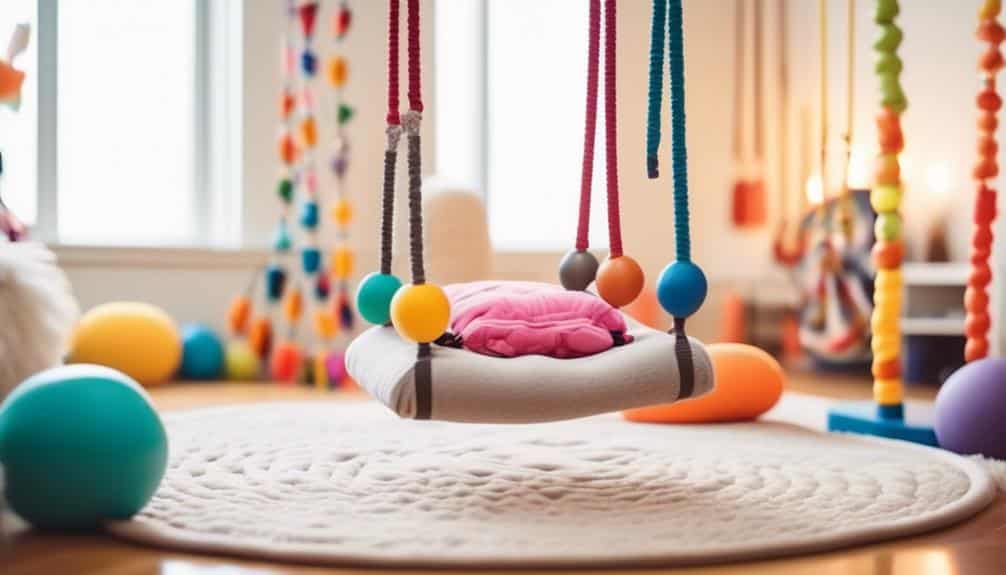In the landscape of therapeutic interventions for autism spectrum disorder (ASD), “Transform Playtime with Purpose – Autism and Sensory Therapy” presents as a compelling paradigm, blending the innate desire for play with structured therapeutic goals. The sensory experiences tailored in this approach are meticulously designed to align with the unique sensory profiles of children with autism, facilitating the acquisition of motor skills and fostering social interaction and emotional regulation.
As we scrutinize the multifaceted nature of play within sensory OT, one cannot help but ponder its implications on the long-term developmental trajectory of these children. The question remains: to what extent does purposeful play shape the neural architecture in ASD, and how can the nuances of sensory integration techniques be optimized to yield the most beneficial outcomes? The ongoing discourse surrounding these queries uncovers layers of complexity and potential that invite further exploration into this intriguing aspect of autism intervention.
Key Takeaways
- Sensory processing differences can impact play in children with autism.
- Tailored sensory activities and assessments help identify and meet sensory needs.
- Structured therapeutic play and tailored sensory activities promote engagement and skill development.
- Creating a safe and sensory-friendly environment promotes sensory integration and self-regulation.
Understanding Sensory Processing
Sensory processing is the critical neurological function whereby the brain decodes and responds to sensory signals, an intricate process that significantly shapes an individual’s experience of the world around them. This encompasses the reception of stimuli through our senses—sight, sound, touch, taste, smell, proprioceptive and vestibular inputs—and our nervous system’s subsequent interpretation and reaction.
For those with sensory processing differences, how they perceive and engage with their environment can vary markedly from what is typically expected. These individuals might experience a sensory stimulus more intensely or weakly, leading to behaviors and emotional responses that might seem disproportionate to the stimulus. Consequently, this can affect their attention, learning, and capacity to navigate through daily activities and social interactions.
Understanding these sensory processing nuances is essential in cultivating supportive and accommodating environments. It enables caregivers, educators, and therapists to adapt activities and routines to align with each individual’s sensory preferences and needs. This empathetic and patient-focused approach fosters participation, learning, and a more meaningful connection with the world for those with sensory processing challenges.
Autism’s Impact on Play
Autism shapes the landscape of play, offering unique avenues for children to engage with and learn from their environment while presenting distinctive challenges requiring thoughtful support and adaptation. Children with autism spectrum disorder (ASD) find play an essential medium for development, as it nurtures a myriad of skills that are vital in their growth:
- Development of Social Skills:
- *Shared Play*: Encourages understanding of sharing and turn-taking.
- *Empathy and Communication*: Through play, children can learn to recognize and respond to the emotions and intentions of others.
- Cognitive and Physical Growth:
- *Exploratory Play*: Facilitates a better grasp of their surroundings through sensory exploration.
- *Cause-and-effect Play*: Develops cognitive skills like anticipating outcomes and understanding the link between actions and consequences.
Playing alongside a child with autism models different types of play and social interactions and strengthens the bond between the child and caregiver, fostering a deeper comprehension of the child’s unique needs. It is through this patient, supportive engagement that children with autism can flourish, making playtime a purposeful endeavor that extends beyond mere amusement to foundational life skill development.
Sensory Integration Techniques

Sensory integration techniques are vital in addressing the unique sensory challenges faced by individuals with autism, aiming to enhance their ability to process and respond to sensory information. By identifying each person’s specific sensory needs, therapists can customize activities that provide the necessary sensory inputs to promote better self-regulation and overall functioning. These tailored sensory activities, such as swinging for vestibular input or deep pressure for proprioceptive feedback, are integral in supporting an individual’s daily life and ensuring a therapeutic approach that is both respectful and responsive to their sensory profile.
Identifying Sensory Needs
Observing their responses to various sensory experiences is essential to support a child with unique sensory processing requirements effectively. By attentively monitoring a child’s behavior, we can discern their sensory preferences and aversions, pivotal in shaping a supportive environment.
- Identifying Sensory Preferences:
- Seeking specific stimuli (e.g., textures, sounds)
- Avoiding overwhelming inputs (e.g., bright lights, loud noises)
- Sensory Assessment Tools:
- Utilizing sensory profiles for a comprehensive understanding
- Implementing assessments to identify sensory processing challenges
Understanding these needs is the cornerstone of creating a sensory diet—structured, personalized activities that provide the necessary sensory input to help children regulate their sensory systems effectively throughout their day. This approach enables children to engage more fully with their surroundings and participate in meaningful activities.
Tailored Sensory Activities
Having identified a child’s unique sensory preferences and challenges, it becomes crucial to implement tailored sensory activities that are carefully curated to foster sensory integration and facilitate better engagement with their environment. These personalized interventions, ranging from sensory diets to specific play activities, are designed to help the child regulate their sensory input, thereby improving their attention span and participation in daily life. Occupational therapists play a vital role in crafting these activities to meet individual needs and promote optimal arousal and attention.
| Technique | Purpose | Example |
|---|---|---|
| Sensory Diets | Regulate sensory input | Customized activity plan |
| Brushing Techniques | Provide tactile stimulation | Gentle skin brushing |
| Weighted Vests | Offer proprioceptive feedback | Wearing during activities |
| Play Activities | Enhance engagement & development | Themed sensory bins |
| Arousal Adjustment | Achieve optimal attention level | Calming or stimulating activities |
Structuring Therapeutic Play
As we transition to the topic of Structuring Therapeutic Play, it is essential to recognize the impact of carefully chosen toys that resonate with the child’s individual interests and therapeutic needs. A well-prepared, safe, and inviting environment sets the stage for children with autism to engage comfortably in play that enriches their sensory experiences. Incorporating sensory activities into play can be a powerful tool, providing a structured yet flexible framework for skill development and positive interactions.
Selecting Appropriate Toys
Selecting toys that cater to the diverse sensory and developmental needs of autistic children is a critical component of structuring therapeutic play that fosters growth and learning. When choosing toys, consider:
- Exploratory Play
- Sensory toys with varying textures
- Objects that encourage tactile exploration
- Cause-and-Effect Play
- Interactive toys responding to the child’s actions
- Items that reward manipulation with lights, sounds, or movement
Additionally:
- Constructive Play
- Building blocks and puzzles for spatial reasoning
- Art supplies for creativity and fine motor skills
- Symbolic Play
- Figurines and pretend sets for imaginative scenarios
- Dress-up costumes to explore different roles and narratives
Focus on toys that align with individual preferences, supporting sensory needs and ongoing skill development in a nurturing and patient-centered approach.
Creating a Safe Environment
Creating a safe and supportive environment is paramount for children with autism as it can significantly enhance their therapeutic play experience by addressing their unique sensory needs and fostering a sense of security. Carefully structuring play allows caregivers and therapists to minimize anxiety and encourage positive interactions with the environment.
| Aspect | Strategy | Benefit |
|---|---|---|
| Boundaries & Routines | Clear, consistent play routines | Instills predictability and safety |
| Sensory-Friendly Materials | Variety of calming toys and materials | Engages and soothes sensory challenges |
| Visual Supports | Use of visual schedules and stories | Provides structure and understanding |
| Designated Space | Sensory-friendly area with minimal distractions | Creates a comfortable therapeutic space |
Each element contributes to a nurturing play space where children with autism can explore, learn, and grow in a manner that respects their sensory preferences and need for structure.
Autism and Sensory Therapy Activities
Building on the foundation of a safe and structured environment, incorporating sensory activities into therapeutic play is essential for engaging and supporting the sensory integration processes of children with autism. These purposefully selected activities can help children regulate their sensory input and foster a sense of calm and focus, which is vital for their growth and development.
- Sensory activities tailored for therapeutic play:
- Tactile experiences include playing with textured materials, encouraging touch exploration, and developing fine motor skills.
- Visual stimulation: using items with contrasting colors or lights to capture attention and aid visual tracking.
- Auditory input: incorporating soothing or rhythmic sounds that can provide a predictable and calming auditory environment.
- Movement-based activities include swinging or balancing exercises that help proprioceptive and vestibular integration.
Sensory-Friendly Play Environments
Accommodating the unique sensory needs of individuals with autism, sensory-friendly play environments are meticulously crafted to reduce sensory overload and foster a welcoming space for play and exploration. These inclusive zones are thoughtfully designed with controlled noise levels, subdued lighting, and gentle tactile experiences to ensure comfort and minimize the possibility of sensory distress.
Sensory-friendly environments are equipped with specialized items like swings that provide vestibular input, balance boards that aid proprioceptive feedback, and tactile walls that encourage touch exploration without overwhelming the senses. Each element is selected to promote sensory integration in a calm and reassuring setting.
For individuals with autism and sensory processing disorders, these environments are not just play areas but vital spaces supporting sensory exploration and self-regulation. They offer opportunities to engage with the world in a manner that is tuned to their sensory preferences, allowing for therapeutic play that is both enjoyable and beneficial.
Occupational Therapy Tools

Recognizing the importance of sensory-friendly environments, occupational therapy further supports individuals with autism by using specialized tools to enhance sensory processing and motor skills. These tools are thoughtfully selected to cater to unique sensory needs, promoting comfort and functional independence.
Occupational therapy tools encompass a range of items, each serving a specific therapeutic purpose:
- Sensory Integration Tools:
- Sensory brushes are used for tactile stimulation and desensitization, helping manage sensory sensitivities.
- Weighted blankets or vests: Provide a calming, grounding sensation, often beneficial in managing anxiety and aiding in focus.
- Tools for Motor Skills and Coordination:
- Fidget toys or stress balls: Assist with tactile sensory input and stress relief, improving hand strength and coordination.
- Therapy bands or resistance bands: Utilized for strengthening exercises and providing proprioceptive input, crucial for body awareness.
- Adaptive utensils or pencil grips: These aids enhance fine motor skills, making writing and eating more accessible.
Playtime Strategies for Parents
Embracing playtime as a vital component of development, parents can employ strategic approaches to nurture their children’s growth and fortify the bond they share. By engaging in play, parents deepen their understanding of their child’s unique needs and reinforce the foundation of a secure and loving relationship. Play allows for demonstrating diverse skills and behaviors, guiding children through the learning process in a supportive and enriching environment.
Incorporating sensory experiences into daily routines enables exploratory play, which is crucial for children with autism. This form of play enhances their ability to process sensory information and fosters cognitive engagement. Parents can introduce cause-and-effect toys to encourage turn-taking and imitation, essential social interaction, and communication skills.
Offering a variety of toys and activities allows children the opportunity to explore and solve problems creatively. Parents need to observe and provide positive feedback, which motivates children and reinforces their efforts and achievements.
Through thoughtful playtime strategies, parents actively participate in their child’s sensory and emotional development, creating a nurturing space for growth and connection.
Measuring Play Therapy Outcomes

While strategic playtime approaches foster developmental growth, evaluating play therapy outcomes is essential to ensure that these practices effectively support children with autism in reaching their full potential. As caregivers and professionals, it is necessary to understand that:
- Measuring play therapy outcomes involves:
- We are assessing changes in behavior, emotional regulation, and social interaction.
- Utilizing a combination of tools, including:
- Standardized assessments that provide objective data.
- Observations and reports from parents and teachers that offer personal insights.
By employing various outcome measures, therapists can track a child’s progress, discern the effectiveness of specific interventions, and adjust strategies to meet individual needs better. Outcome measures facilitate personalized therapy plans and encourage collaboration by providing clear, shared data for all involved in the child’s care.
Furthermore, the commitment to measuring outcomes underpins evidence-based practice, ensuring that play therapy remains a dynamic and reflective process. This dedication to continuous improvement demonstrates a heartfelt investment in enhancing the lives of children with autism, and it is a cornerstone of patient-focused care for those who deeply value serving and supporting this community.
Advancements in Sensory OT
Advancements in Sensory Occupational Therapy (OT) have revolutionized the approach to assisting autistic children, providing them with innovative tools and personalized strategies to navigate and regulate their sensory experiences more effectively. The adoption of technology, such as virtual reality, has enabled the creation of controlled sensory environments that can be used to simulate real-world scenarios in a safe and manageable way. This is particularly beneficial for children who may find specific sensory inputs overwhelming.
Research has also been integral in shaping modern Sensory OT interventions. With a deeper understanding of sensory processing and its impact on functional skills, therapists can more accurately tailor their approaches to suit each child’s needs.
To further elucidate the progress in Sensory OT, consider the following table:
| Advancement | Impact on Therapy |
|---|---|
| Personalized Strategies | Ensures interventions are tailored to individual needs |
| Virtual Reality | Provides controlled, immersive environments for safe exploration |
| Research-Based Interventions | This leads to targeted therapy for enhanced outcomes |
These developments have not only advanced therapeutic practices but also fostered greater empathy and understanding in supporting individuals with autism, ensuring a more inclusive society where every child is allowed to thrive.
Frequently Asked Questions
What Are the 3 Main Symptoms of Autism?
The three primary symptoms of autism include challenges with social interaction, difficulties with communication, and a tendency to engage in repetitive behaviors. Early intervention is crucial for supporting individuals on the autism spectrum.
What Do Autistic People Struggle With?
Navigating a labyrinth of social cues, autistic individuals often face challenges in communication, social interaction, and repetitive behaviors, which may hinder their ability to integrate into communal play and social engagements seamlessly.
What Are the Coping Mechanisms for High Functioning Autism?
High-functioning autistic individuals often employ self-regulation techniques, repetitive behaviors, and stimming to manage anxiety and sensory challenges, facilitating their ability to navigate complex social and environmental stimuli with greater ease.
Why Do Individuals with Autism Like Parallel Play?
Autistic individuals often prefer parallel play as it allows them to engage comfortably at their own pace, reducing social pressure and sensory overload while providing a foundation for gradually developing social interaction skills.
Conclusion
Pediatric occupational therapy is an effective intervention for children with autism spectrum disorder. Children with autism struggle with sensory processing, communication, social behaviors, and problem-solving skills. Sensory activities and motor activities can help children with autism learn essential skills.
In an American Journal of Occupational Therapy study, therapy interventions for children with autism spectrum disorder were found to have numerous benefits. Sensory integration therapy, a type of occupational therapy, helps children with autism process sensory information. This therapy creates a safe space for children to develop their skills in a supportive environment.
During therapy sessions, children with autism can learn to regulate their arousal levels and sensory processing abilities. Sensory processing difficulties can cause sensory overload, but deep pressure, visual schedules, and social stories can help children cope.
Play-based interventions, such as Ayres Sensory Integration or DIRFloortime, provide the right challenges to help children develop motor, communication, and emotional skills. Weighted vests, joint compressions, and DIRFloortime are also used in therapy for autism.
Occupational therapy evaluations can help therapists create an engaging environment for children with autism. The interventions used in therapy can have critical benefits for children with autism, leading to positive outcomes in their daily lives.
In conclusion, occupational therapy services offer interventions for children with autism that can help them overcome their challenges and develop their skills. Therapy interventions can support children with autism to improve their sensory processing differences, maladaptive behaviors, and self-stimulatory behaviors. With the right therapy in a structured environment, children with autism can thrive and reach their potential.


Recent Comments